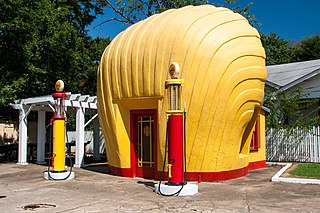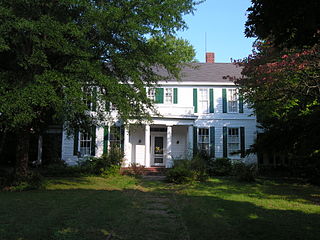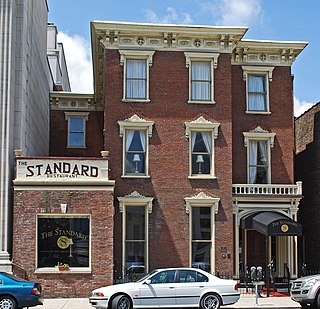
Sevierville is a city in and the county seat of Sevier County, Tennessee, located in eastern Tennessee. The population was 14,807 at the 2010 United States Census and 17,117 according to the 2019 census estimate.
This is a list of properties and historic districts in Tennessee that are listed on the National Register of Historic Places. There are over 2,000 in total. Of these, 29 are National Historic Landmarks. Each of Tennessee's 95 counties has at least one listing.

The Fulton Mansion State Historic Site is located in Fulton on the Texas Gulf Coast, in the county of Aransas, in the U.S. state of Texas. It is one of the earliest Second Empire style buildings constructed in Texas and is one of the most important of the style in the Southwest United States still in existence. Colonel George Ware Fulton and Harriet Gillette Smith began building the 4 story structure overlooking Aransas Bay in 1874 and finished in 1877. The residence, dubbed "Oakhurst" by its owners George & Harriet, featured the most up-to-date conveniences for the time, such as indoor plumbing reaching sinks in every bedroom, gas lighting and central heating, along with three bathrooms and two built-in copper tubs.

The Shell Service Station in Winston-Salem, Forsyth County, North Carolina, was a filling station constructed in 1930 following a decision in the 1920s by the new local Shell distributor, Quality Oil Co., to bring brand awareness to the market in Winston-Salem. The building is an example of representational or novelty architecture and was listed on the National Register of Historic Places on May 13, 1976. It is located in the Waughtown-Belview Historic District.

The William H. Copeland House is a home located in the Chicago suburb of Oak Park, Illinois, United States. In 1909 the home underwent a remodeling designed by famous American architect Frank Lloyd Wright. The original Italianate home was built in the 1870s. Dr. William H. Copeland commissioned Wright for the remodel and Wright's original vision of the project proposed a three-story Prairie house. That version was rejected and the result was the more subdued, less severely Prairie, William H. Copeland House. On the exterior the most significant alteration by Wright was the addition of a low-pitched hip roof. The house has been listed as a contributing property to a U.S. Registered Historic District since 1973.

The F. Julius LeMoyne House is a historic house museum at 49 East Maiden Street in Washington, Pennsylvania. Built in 1812, it was the home of Dr. Francis Julius LeMoyne (1798–1897), an antislavery activist who used it as a stop on the Underground Railroad. LeMoyne also assisted in the education of freed slaves after the American Civil War, founding the historically black LeMoyne–Owen College in Memphis, Tennessee. His house, now operated as a museum by the local historical society, was designated a National Historic Landmark in 1997. It is designated as a historic public landmark by the Washington County History & Landmarks Foundation.

This is a list of the National Register of Historic Places listings in Stearns County, Minnesota. It is intended to be a complete list of the properties and districts on the National Register of Historic Places in Stearns County, Minnesota, United States. The locations of National Register properties and districts for which the latitude and longitude coordinates are included below, may be seen in an online map.
This is a list of the National Register of Historic Places listings in Shelby County, Tennessee.
This is a list of the National Register of Historic Places listings in Williamson County, Tennessee.

This is a list of the National Register of Historic Places listings in Todd County, Minnesota. It is intended to be a complete list of the properties and districts on the National Register of Historic Places in Todd County, Minnesota, United States. The locations of National Register properties and districts for which the latitude and longitude coordinates are included below, may be seen in an online map.

Belle Mont is a historic Jeffersonian-style plantation house near Tuscumbia in Colbert County, Alabama. It was added to the National Register of Historic Places on February 23, 1982, due to its architectural significance.

Winston Place is a historic residence in Valley Head, Alabama. William O. Winston, a lawyer from Rogersville, Tennessee, moved to DeKalb County in 1838. Winston would later serve in the Alabama House of Representatives and was a major investor in the Wills Valley Railroad, which would later connect Chattanooga with Birmingham. Soon after arriving in Alabama, Winston built a two-story I-house. In the late 19th century, the exterior was extensively modified with a two-story, wrap-around, Colonial Revival porch and tetrastyle portico. Around 1930, rear outbuildings were connected to the house, giving it an L-shaped plan. The house was listed on the Alabama Register of Landmarks and Heritage in 1976 and the National Register of Historic Places in 1987.

Oakslea Place is a historic mansion in Jackson, Tennessee, USA. Built circa 1860, prior to the American Civil War, it was expanded in 1900.

Longview is a historic mansion in Nashville, Tennessee, USA.

The Read House Hotel is a historic hotel in Chattanooga, Tennessee. The current building dates from 1926, and is listed on the National Register of Historic Places for Hamilton County.

The Savage House is a historic three-storey townhouse in Nashville, Tennessee, USA.

Greenwood Memory Lawn Mortuary & Cemetery is the official name given to a cemetery located at 2300 West Van Buren Street in Phoenix, Arizona owned by Dignity Memorial. The cemetery, which resulted as a merger of two historical cemeteries, Greenwood Memorial Park and Memory Lawn Memorial Park, is the final resting place of various notable former residents of Arizona. Pioneers, governors, congressman, government officials, journalists, race car drivers, soldiers, actors and actresses are among the many notable decedents who are interred in the cemetery.

The Copeland-Whitfield House is a historic mansion in Pulaski, Tennessee, U.S..
The Noblit–Lytle House was a classic example of a log dog-trot house built in 1848 and located in Minor Hill, Tennessee, U.S. It was listed on the National Register of Historic Places between 2008 and 2018, when it was demolished.

Winston Evans House is a historic house in Shelbyville, Tennessee, U.S.. The two-story house was built in 1900 for Winston Evans and his wife Carrie Frierson, whose family owned the land and built the Frierson-Coble House nearby. It was designed in the Classical Revival architectural style. It has been listed on the National Register of Historic Places since November 27, 1989.
















